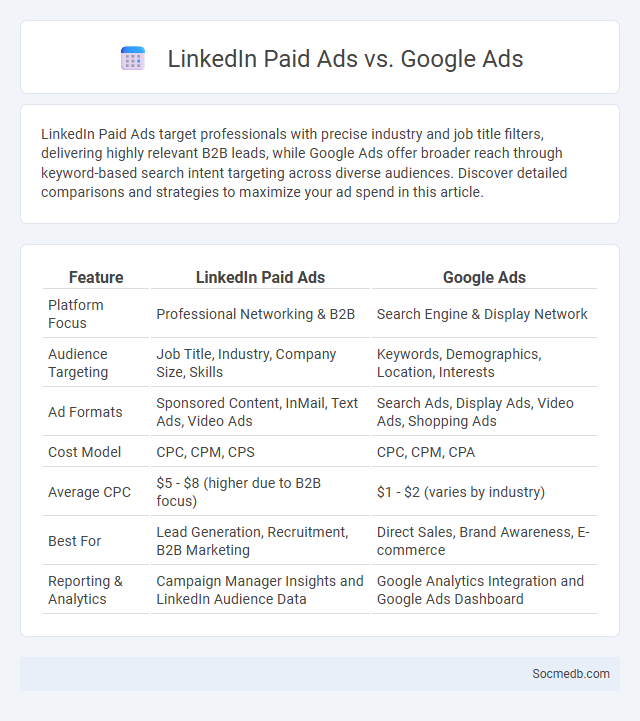
Photo illustration: LinkedIn Paid Ads vs Google Ads
LinkedIn Paid Ads target professionals with precise industry and job title filters, delivering highly relevant B2B leads, while Google Ads offer broader reach through keyword-based search intent targeting across diverse audiences. Discover detailed comparisons and strategies to maximize your ad spend in this article.
Table of Comparison
| Feature | LinkedIn Paid Ads | Google Ads |
|---|---|---|
| Platform Focus | Professional Networking & B2B | Search Engine & Display Network |
| Audience Targeting | Job Title, Industry, Company Size, Skills | Keywords, Demographics, Location, Interests |
| Ad Formats | Sponsored Content, InMail, Text Ads, Video Ads | Search Ads, Display Ads, Video Ads, Shopping Ads |
| Cost Model | CPC, CPM, CPS | CPC, CPM, CPA |
| Average CPC | $5 - $8 (higher due to B2B focus) | $1 - $2 (varies by industry) |
| Best For | Lead Generation, Recruitment, B2B Marketing | Direct Sales, Brand Awareness, E-commerce |
| Reporting & Analytics | Campaign Manager Insights and LinkedIn Audience Data | Google Analytics Integration and Google Ads Dashboard |
Overview: LinkedIn Paid Ads, Google Ads, and Lead Generation
LinkedIn Paid Ads offer precise targeting by industry, job function, and company size, making them ideal for B2B lead generation campaigns. Google Ads leverage keyword intent and search behavior to capture high-intent leads through search and display networks, maximizing conversion potential. Combining LinkedIn's professional audience targeting with Google Ads' intent-driven reach creates a powerful strategy for scalable and effective lead generation.
Target Audience Comparison
Social media platforms vary significantly in user demographics, with Instagram appealing primarily to younger audiences aged 18-34, while Facebook maintains a broader, more diverse user base including older adults. LinkedIn targets professionals and business-oriented users, making it ideal for B2B marketing, whereas TikTok's audience skews younger, focusing on Gen Z and content centered around entertainment and trends. Understanding these distinct target audience profiles is critical for crafting effective marketing strategies that maximize engagement and conversions.
Ad Formats and Features
Social media platforms offer a variety of ad formats, including sponsored posts, carousel ads, video ads, and interactive stories, each designed to maximize user engagement and brand visibility. Features such as precise audience targeting, real-time analytics, and A/B testing enable advertisers to optimize campaign performance and achieve higher conversion rates. Leveraging native ads and shoppable posts further enhances the shopping experience by integrating seamless buying options within social feeds.
Cost and Budget Considerations
Allocating Your budget effectively in social media marketing ensures maximum return on investment by targeting platforms with the highest engagement rates for Your industry. Costs vary significantly across channels like Facebook, Instagram, and LinkedIn, influenced by ad formats, audience size, and campaign duration. Monitoring analytics and adjusting spending based on performance metrics helps optimize Your social media expenses and achieve business goals within budget constraints.
Lead Quality and Conversion Rates
Social media platforms provide powerful tools to target specific demographics, enhancing lead quality by attracting users genuinely interested in your products or services. High-quality leads from well-segmented campaigns increase conversion rates, as these prospects are more likely to engage and complete desired actions. Optimizing your social media strategies with precise audience insights ensures you maximize ROI through improved lead generation and higher conversion rates.
Industry Suitability and Use Cases
Social media platforms cater to diverse industries, including retail, healthcare, finance, and entertainment, each benefiting from tailored content strategies and targeted advertising. Your business can leverage social media for customer engagement, brand awareness, lead generation, and real-time customer support, enhancing overall market reach. Analytics tools embedded in these platforms also provide valuable insights into consumer behavior, enabling more informed marketing decisions for industry-specific growth.
Campaign Setup and Management
Campaign setup and management on social media involves strategic targeting, budget allocation, and creative content development to maximize engagement and ROI. Key steps include audience segmentation using platform-specific analytics, precise ad placement, and continuous performance tracking through metrics like click-through rates and conversion rates. Effective management requires adjusting bids, testing ad variations, and leveraging tools such as Facebook Ads Manager or Google Ads for optimized campaign outcomes.
Analytics and Performance Tracking
Social media analytics involves collecting and analyzing data from platforms like Facebook, Instagram, and Twitter to measure content effectiveness, audience engagement, and campaign ROI. Key performance indicators include reach, impressions, click-through rates, and conversion rates, which help marketers refine strategies and optimize ad spend. Advanced tools like Google Analytics, Hootsuite Insights, and Sprout Social enable real-time performance tracking, providing actionable insights for continuous improvement.
Pros and Cons of Each Platform
Facebook offers robust community-building tools and detailed user analytics, making it ideal for targeted marketing campaigns; however, privacy concerns and algorithm-driven content delivery can reduce organic reach. Instagram excels in visual storytelling and influencer partnerships, enhancing brand visibility, but its emphasis on aesthetics may limit deeper engagement and skew user perception. Twitter facilitates real-time communication and trending topic engagement, benefiting quick information dissemination, while its character limit and fast-paced environment can hinder nuanced discussions. Your choice should align with your specific goals, audience, and content strategy to maximize benefits and mitigate drawbacks across platforms.
Choosing the Right Platform for Your Business Goals
Selecting the right social media platform hinges on aligning its user demographics and content formats with your specific business goals. For B2B companies, LinkedIn offers targeted networking opportunities, while Instagram and TikTok excel in visual storytelling for consumer brands. Analyzing audience engagement metrics and platform algorithms ensures optimal reach and ROI tailored to your marketing strategy.
 socmedb.com
socmedb.com